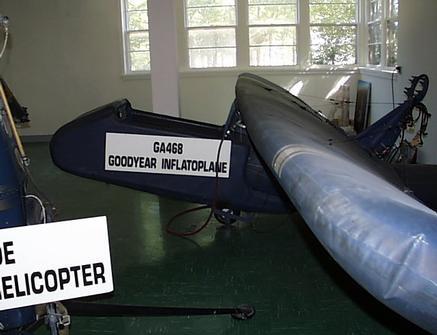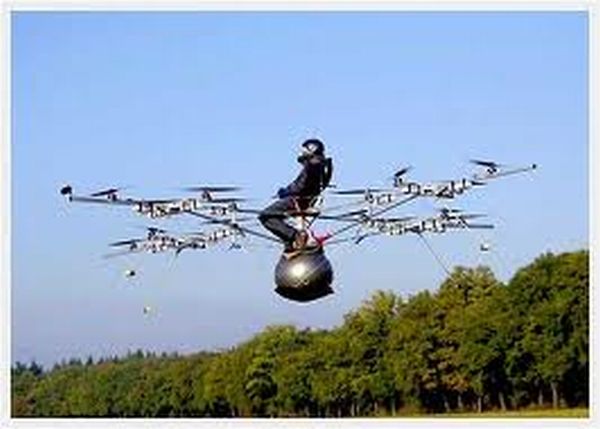Around 1974 or so, my Air Force Junior ROTC class took a bus trip down to Fort Rucker, AL. Got to see a "live fire" of some 3" missiles from an Apache that flew about 200 yards past us at high speed, and we saw the warhead explode about a mile away.
Anyway, they also had a museum of US Army Aircraft. And an inflatoplane was one of them. Tonight, I looked it up, and sure enough.... it still lis there.
https://bayourenaissanceman.blogspot.com/2008/06/weekend-wings-20-inflatable-aircraft.html
Now, these days, there would be no need for and inflatable plane for a "behind the lines" rescue. We have way better technology.
There was a Christmas video by Casey Neistat, who is a master at creating Youtube videos (He did a daily Vlog for nearly 2 years, stopped last fall). One reason he stopped was to be able to spend more time doing special videos requiring a lot of time and planning, the daily vlog grind didn't allow for that. He went to Finland to shoot this, at a "Santa's Village", and also no issues with the FAA outside of the U.S. The local authorities were aware and gave permission for him to do it.
Anyway..... he used a huge R/C Drone to pull himself along on skis, such as riding up a ski slope. But most spectacularly, HE FLEW!. There was a cable running down his arm to a body harness, though it looks in the video like he was just holding on by one hand. Anyway, the drone had over 1000 pounds of thrust, easily lifting him. The drone operator was careful not to carry him up TOO high.
You will need to go to youtube and search for "Human Flying Drone", to see that video. It is the one that runs for 4:13. There is a reason why I'm not posting the link directly, won't elaborate, so sorry for the need to search for it. But there's a good reason to bother, it's really neat (also see the pic at the end of this post)

What occurred to me later, is that drone had so much battery power to it, and so much overkill thrust, that something like that could be developed for military rescue. Perhaps have it fold up into a smaller package, so it could possibly be carried under the wing of an attack jet to overfly a downed pilot and be dropped from very high altitude like a bomb (a opposed to dumping out the back of a C-130, slow and risky). Except once it slowed enough and deployed, it could go to very low throttle and steer itself down to where it had been programmed the pilot would be (and/or capable of live updates from some other aircraft or possible beacon the pilot might have). Would not require a lot of battery power to fly itself down, unless for safety of the aircraft carrying it, it was dropped say 10-20 miles away (from say 30,000 feet) and had to travel horizontally a good ways. But it could be designed to use a "landing battery", so after landing that battery could be jettisoned.
The pilot would have to put on some sort of harness (the drone would bring it) and clip onto the rescue drone's cable. Then when he was ready, press a "Get me outta here!" button , stand to one side, and wait for the drone to take off and get high enough for the pilot to walk underneath so by the time the cable lifted the pilot up it would be a vertical lift. It would then automatically fly to a designated rescue landing location. Range could perhaps be 20 miles or more, would really depend on the battery capacity and efficient of the drones motors, props and such (Which would be pretty highly efficient for the right price).
Now if the range were only 20 miles, maybe that's not enough to fly a pilot back across the lines. But it would allow the capability to fly the pilot to a "safer area" with no known enemy anywhere near, and a rescue helicopter could fly to land there about the same time as the pilot did. In theory the downed pilot could be flying inside the rescue helicopter one minute after the drone landed.
Now, there are some real-world "rescue" drones being worked on for civilian uses, such as swimmers in the ocean or survivors of sunken boats. So the whole "fly a human back" rescue drone is not a new idea. Also, there have been several successful "climb aboard, sit in the seat, and fly yourself" drones. The one below is one of the earliest (Pilot controlling by holding R/C Transmitter in his lap) , if not the first, by "Volo", who has a much more advanced and robust prototype now, with cockpit.
See their site:
https://volocopter.com/index.php/en/
But those "sit in" types are too bulky and complex to try to make into something to be folded up and transported rapidly.
But I have not run across anything about a possible military rescue as I just described. I'd expect something like that is being studied, at the least, if not already being prototyped. Could even be a DARPA thing. Although while DARPA is the tip of the spear of publicly known military R&D (not that they reveal THAT much of all they are doing)..... I'm not so sure how well rescue may fit in among their mission charter for researching advanced military technology. So it might be something more along the lines for a military branch to have an RFP for (though all branches would have a need for this), or for some company to secretly propose.
Also while this has focused on a downed pilot scenario, if those could be made 'cheaply" enough to have LOTS of them, then also situations where an army patrol of say 8 troops might be trapped...... send a "swarm" of these things in, hook everybody up to one, and fly 'em all out. If they could hole up in a small safe haven for long enough to pull it off and fly out in some initial vector that could avoid being shot at too easily (clearly not practical in all situations, but many times could be). Weather too bad for a rescue copter? Not these things! Some of the consumer Drones like the DJI Phantoms can hover over one spot, in 40 mph wind, with gusts. No visibility? Drones don't care....a lot can autoland blindly. Or if none of that might be practical, a pinned down patrol running out of ammo...... use powerful drones like this to precisely land ammo and other critical supplies when a regular air drop is no good.
Anyway, I was considering those things in December, and with a big reason for the inflatable plane being for rescue of people trapped behind the lines, thought I'd mention it.
BTW - below was shot using a 360 degree camera at the end of a stick he held with his left hand.








